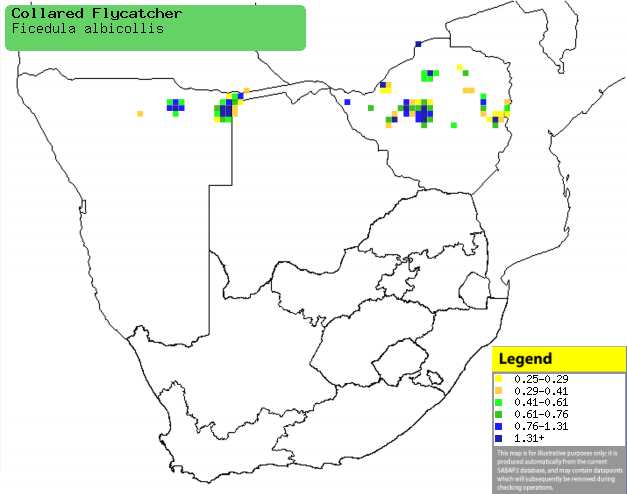|
Ficedula albicollis (Collared flycatcher)
WithalsvlieŽvanger [Afrikaans]; Withalsvliegenvanger [Dutch]; Gobemouche
ŗ collier [French]; Halsbandschnšpper [German]; Papa-moscas-de-colar
[Portuguese]
Life
> Eukaryotes >
Opisthokonta
> Metazoa (animals) >
Bilateria >
Deuterostomia > Chordata >
Craniata > Vertebrata (vertebrates) > Gnathostomata (jawed
vertebrates) > Teleostomi (teleost fish) > Osteichthyes (bony fish) > Class:
Sarcopterygii (lobe-finned
fish) > Stegocephalia (terrestrial
vertebrates) > Tetrapoda
(four-legged vertebrates) > Reptiliomorpha > Amniota >
Reptilia (reptiles) >
Romeriida > Diapsida > Archosauromorpha > Archosauria >
Dinosauria
(dinosaurs) > Saurischia > Theropoda (bipedal predatory dinosaurs) >
Coelurosauria > Maniraptora > Aves
(birds) > Order: Passeriformes
> Family: Muscicapidae
Distribution and habitat
Its breeding grounds are in central and south-eastern
Europe; in the non-breeding season it heads south though the centre of Africa to
the DRC, Zambia and Tanzania, marginally extending into southern Africa. Here it
is a rare summer vagrant, occasionally occurring in the northern half of
Zimbabwe and the north-eastern corner of Namibia (not in the Caprivi Strip). It
has only been recorded moist woodland, forest edges and open country with
scattered trees.
|
 |
|
Distribution of Collared flycatcher in southern
Africa, based on statistical smoothing of the records from first SA Bird
Atlas Project (©
Animal Demography unit, University of
Cape Town; smoothing by Birgit Erni and Francesca Little). Colours range
from dark blue (most common) through to yellow (least common). |
Threats
Not threatened.
References
-
Hockey PAR, Dean WRJ and Ryan PG 2005. Roberts
- Birds of southern Africa, VIIth ed. The Trustees of the John Voelcker
Bird Book Fund, Cape Town.
|
